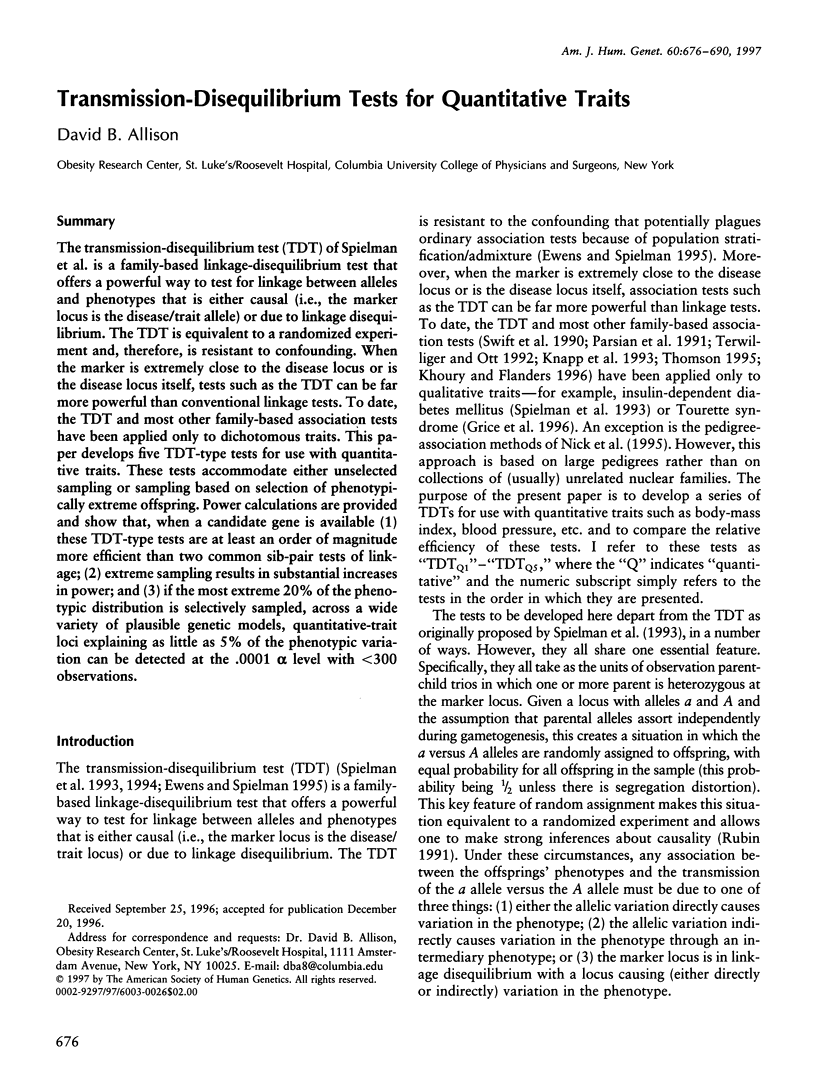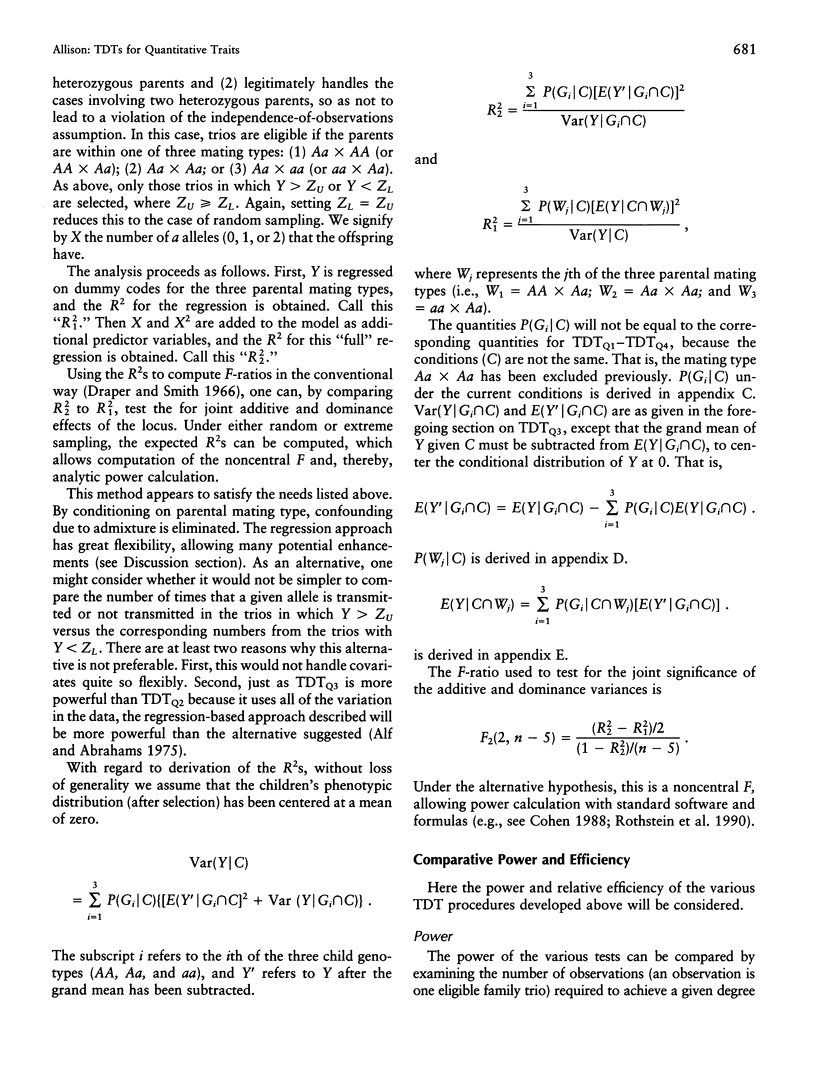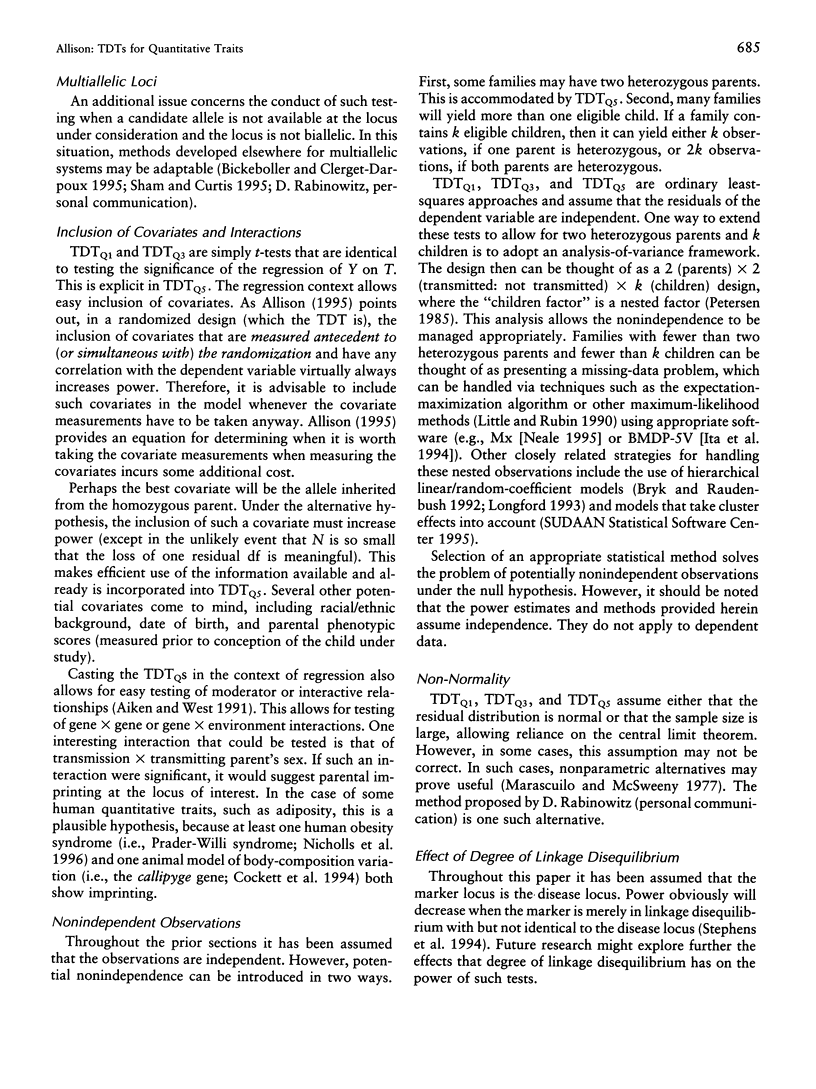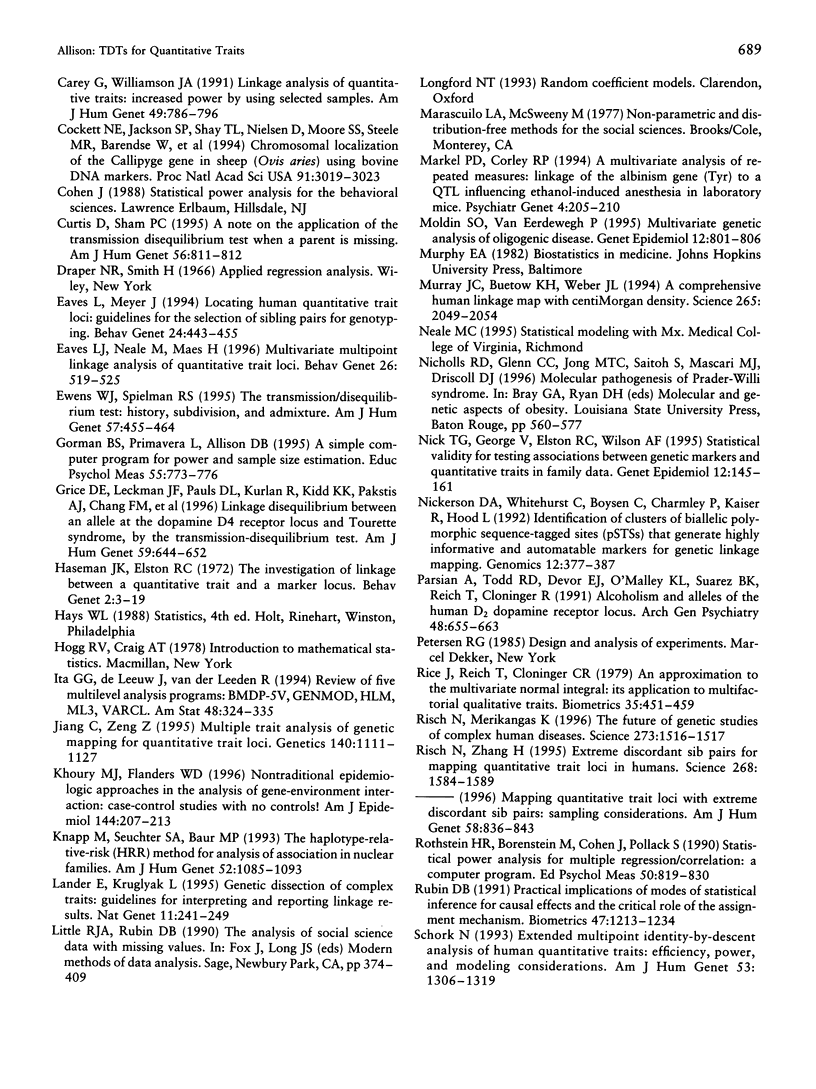Abstract
The transmission-disequilibrium test (TDT) of Spielman et al. is a family-based linkage-disequilibrium test that offers a powerful way to test for linkage between alleles and phenotypes that is either causal (i.e., the marker locus is the disease/trait allele) or due to linkage disequilibrium. The TDT is equivalent to a randomized experiment and, therefore, is resistant to confounding. When the marker is extremely close to the disease locus or is the disease locus itself, tests such as the TDT can be far more powerful than conventional linkage tests. To date, the TDT and most other family-based association tests have been applied only to dichotomous traits. This paper develops five TDT-type tests for use with quantitative traits. These tests accommodate either unselected sampling or sampling based on selection of phenotypically extreme offspring. Power calculations are provided and show that, when a candidate gene is available (1) these TDT-type tests are at least an order of magnitude more efficient than two common sib-pair tests of linkage; (2) extreme sampling results in substantial increases in power; and (3) if the most extreme 20% of the phenotypic distribution is selectively sampled, across a wide variety of plausible genetic models, quantitative-trait loci explaining as little as 5% of the phenotypic variation can be detected at the .0001 alpha level with <300 observations.
Full text
PDF














Selected References
These references are in PubMed. This may not be the complete list of references from this article.
- Allison D. B. When is it worth measuring a covariate in a randomized clinical trial? J Consult Clin Psychol. 1995 Jun;63(3):339–343. doi: 10.1037//0022-006x.63.3.339. [DOI] [PubMed] [Google Scholar]
- Amos C. I., Laing A. E. A comparison of univariate and multivariate tests for genetic linkage. Genet Epidemiol. 1993;10(6):671–676. doi: 10.1002/gepi.1370100657. [DOI] [PubMed] [Google Scholar]
- Bickeböller H., Clerget-Darpoux F. Statistical properties of the allelic and genotypic transmission/disequilibrium test for multiallelic markers. Genet Epidemiol. 1995;12(6):865–870. doi: 10.1002/gepi.1370120656. [DOI] [PubMed] [Google Scholar]
- Boomsma D. I. Using multivariate genetic modeling to detect pleiotropic quantitative trait loci. Behav Genet. 1996 Mar;26(2):161–166. doi: 10.1007/BF02359893. [DOI] [PubMed] [Google Scholar]
- Carey G., Williamson J. Linkage analysis of quantitative traits: increased power by using selected samples. Am J Hum Genet. 1991 Oct;49(4):786–796. [PMC free article] [PubMed] [Google Scholar]
- Cockett N. E., Jackson S. P., Shay T. L., Nielsen D., Moore S. S., Steele M. R., Barendse W., Green R. D., Georges M. Chromosomal localization of the callipyge gene in sheep (Ovis aries) using bovine DNA markers. Proc Natl Acad Sci U S A. 1994 Apr 12;91(8):3019–3023. doi: 10.1073/pnas.91.8.3019. [DOI] [PMC free article] [PubMed] [Google Scholar]
- Eaves L. J., Neale M. C., Maes H. Multivariate multipoint linkage analysis of quantitative trait loci. Behav Genet. 1996 Sep;26(5):519–525. doi: 10.1007/BF02359757. [DOI] [PubMed] [Google Scholar]
- Ewens W. J., Spielman R. S. The transmission/disequilibrium test: history, subdivision, and admixture. Am J Hum Genet. 1995 Aug;57(2):455–464. [PMC free article] [PubMed] [Google Scholar]
- Grice D. E., Leckman J. F., Pauls D. L., Kurlan R., Kidd K. K., Pakstis A. J., Chang F. M., Buxbaum J. D., Cohen D. J., Gelernter J. Linkage disequilibrium between an allele at the dopamine D4 receptor locus and Tourette syndrome, by the transmission-disequilibrium test. Am J Hum Genet. 1996 Sep;59(3):644–652. [PMC free article] [PubMed] [Google Scholar]
- Haseman J. K., Elston R. C. The investigation of linkage between a quantitative trait and a marker locus. Behav Genet. 1972 Mar;2(1):3–19. doi: 10.1007/BF01066731. [DOI] [PubMed] [Google Scholar]
- Jiang C., Zeng Z. B. Multiple trait analysis of genetic mapping for quantitative trait loci. Genetics. 1995 Jul;140(3):1111–1127. doi: 10.1093/genetics/140.3.1111. [DOI] [PMC free article] [PubMed] [Google Scholar]
- Khoury M. J., Flanders W. D. Nontraditional epidemiologic approaches in the analysis of gene-environment interaction: case-control studies with no controls! Am J Epidemiol. 1996 Aug 1;144(3):207–213. doi: 10.1093/oxfordjournals.aje.a008915. [DOI] [PubMed] [Google Scholar]
- Knapp M., Seuchter S. A., Baur M. P. The haplotype-relative-risk (HRR) method for analysis of association in nuclear families. Am J Hum Genet. 1993 Jun;52(6):1085–1093. [PMC free article] [PubMed] [Google Scholar]
- Lander E., Kruglyak L. Genetic dissection of complex traits: guidelines for interpreting and reporting linkage results. Nat Genet. 1995 Nov;11(3):241–247. doi: 10.1038/ng1195-241. [DOI] [PubMed] [Google Scholar]
- Moldin S. O., Van Eerdewegh P. Multivariate genetic analysis of an oligogenic disease. Genet Epidemiol. 1995;12(6):801–806. doi: 10.1002/gepi.1370120645. [DOI] [PubMed] [Google Scholar]
- Nick T. G., George V., Elston R. C., Wilson A. F. Statistical validity for testing associations between genetic markers and quantitative traits in family data. Genet Epidemiol. 1995;12(2):145–161. doi: 10.1002/gepi.1370120204. [DOI] [PubMed] [Google Scholar]
- Nickerson D. A., Whitehurst C., Boysen C., Charmley P., Kaiser R., Hood L. Identification of clusters of biallelic polymorphic sequence-tagged sites (pSTSs) that generate highly informative and automatable markers for genetic linkage mapping. Genomics. 1992 Feb;12(2):377–387. doi: 10.1016/0888-7543(92)90388-9. [DOI] [PubMed] [Google Scholar]
- Parsian A., Todd R. D., Devor E. J., O'Malley K. L., Suarez B. K., Reich T., Cloninger C. R. Alcoholism and alleles of the human D2 dopamine receptor locus. Studies of association and linkage. Arch Gen Psychiatry. 1991 Jul;48(7):655–663. doi: 10.1001/archpsyc.1991.01810310073013. [DOI] [PubMed] [Google Scholar]
- Risch N., Merikangas K. The future of genetic studies of complex human diseases. Science. 1996 Sep 13;273(5281):1516–1517. doi: 10.1126/science.273.5281.1516. [DOI] [PubMed] [Google Scholar]
- Risch N., Zhang H. Extreme discordant sib pairs for mapping quantitative trait loci in humans. Science. 1995 Jun 16;268(5217):1584–1589. doi: 10.1126/science.7777857. [DOI] [PubMed] [Google Scholar]
- Rubin D. B. Practical implications of modes of statistical inference for causal effects and the critical role of the assignment mechanism. Biometrics. 1991 Dec;47(4):1213–1234. [PubMed] [Google Scholar]
- Schork N. J. Extended multipoint identity-by-descent analysis of human quantitative traits: efficiency, power, and modeling considerations. Am J Hum Genet. 1993 Dec;53(6):1306–1319. [PMC free article] [PubMed] [Google Scholar]
- Sham P. C., Curtis D. An extended transmission/disequilibrium test (TDT) for multi-allele marker loci. Ann Hum Genet. 1995 Jul;59(Pt 3):323–336. doi: 10.1111/j.1469-1809.1995.tb00751.x. [DOI] [PubMed] [Google Scholar]
- Sheffield V. C., Nishimura D. Y., Stone E. M. Novel approaches to linkage mapping. Curr Opin Genet Dev. 1995 Jun;5(3):335–341. doi: 10.1016/0959-437x(95)80048-4. [DOI] [PubMed] [Google Scholar]
- Spielman R. S., McGinnis R. E., Ewens W. J. Transmission test for linkage disequilibrium: the insulin gene region and insulin-dependent diabetes mellitus (IDDM). Am J Hum Genet. 1993 Mar;52(3):506–516. [PMC free article] [PubMed] [Google Scholar]
- Stephens J. C., Briscoe D., O'Brien S. J. Mapping by admixture linkage disequilibrium in human populations: limits and guidelines. Am J Hum Genet. 1994 Oct;55(4):809–824. [PMC free article] [PubMed] [Google Scholar]
- Swift M., Kupper L. L., Chase C. L. Effective testing of gene-disease associations. Am J Hum Genet. 1990 Aug;47(2):266–274. [PMC free article] [PubMed] [Google Scholar]
- Terwilliger J. D., Ott J. A haplotype-based 'haplotype relative risk' approach to detecting allelic associations. Hum Hered. 1992;42(6):337–346. doi: 10.1159/000154096. [DOI] [PubMed] [Google Scholar]
- Thomson G. Mapping disease genes: family-based association studies. Am J Hum Genet. 1995 Aug;57(2):487–498. [PMC free article] [PubMed] [Google Scholar]


